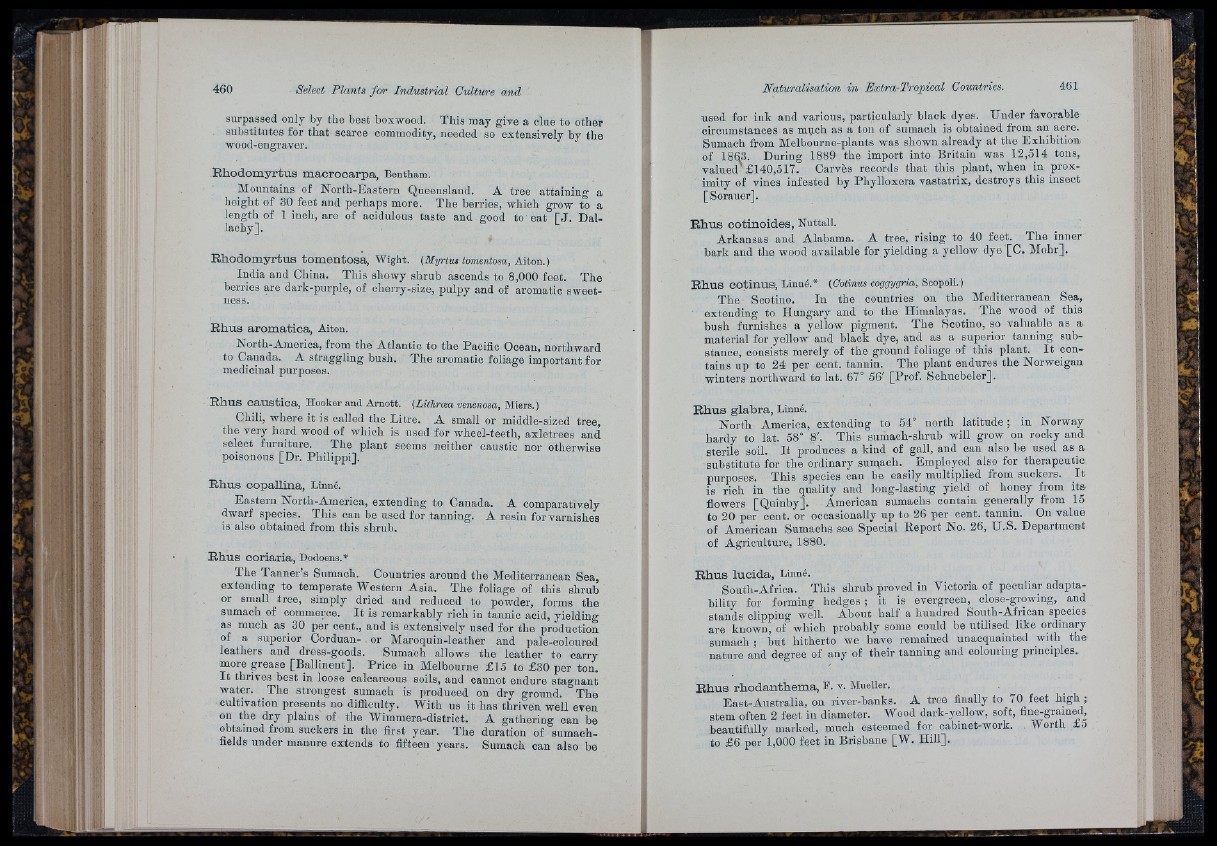
surpassed only by tbe best boxwood. This may give a clue to other
substitutes for that scarce commodity, needed so extensively by the
wood-engraver.
R h o d om y r tu s m a c ro c a rp a , Bentham.
Mountains of North-Eastern Queensland. A tree attaining a
height of 30 feet and perhaps more. The berries, which grow to a
length of 1 inch, are of acidulous taste and good to eat [ J . Dal-
lachy].
R h o d om y r tu s tom e n to s a , Wight. (Myrtu» tomentosa, Aiton.)
India and China. This showy shrub ascends to 8,000 feet. The
berries are dark-purple, of cherry-size, pulpy aud of aromatic sweetness.
R h u s a rom a tic a , Aiton.
North-Ameriea, from the Atlantic to the Pacific Ocean, northward
to Canada. A straggling bush. The aromatic foliage important for
medicinal purposes.
R h u s c a u s tic a , Hooker and Arnott. (Lithraa venenosa, MXem.)
Chili, where it is called the Litre. A small or middle-sized tree,
the very hard wood of which is nsed for wheel-teetli, axletrees and
select furniture. The plant seems neither caustic nor otherwise
poisonous [Dr. Philippi].
R h u s c o p a llin a , Linné.
Eastern North-America, extending to Canada,
dwarf species. This can be used for tanning,
is also obtained from this shrub.
A comparatively
A resin for varnishes
R h u s c o ria ria , Dodoens.*
The Tanner’s Snmach. Countries around the Mediterranean Sea,
extending to temperate Western Asia. The foliage of this shrub
or small tree, simply dried and reduced to powder, forms the
sumach of commerce. I t is remarkably rich iu tannic aoid, yielding
as much as 30 per cent., and is extensively used for the production
of a superior Corduan- or Maroquin-leather and pale-coloured
leathers and dress-goods. Sumach allows the leather to carry
more grease [Ballinent]. Price in Melbourne £15 to £30 per ton.
I t thrives best in loose calcareous soils, aud cannot endure stagnant
water. The strongest sumach is produced ou dry ground. The
cultivation presents no difficulty. With us it has thriven well even
on the dry plains of the Wimmera-district. A gathering can be
obtained from suckers in the first year. The duration of sumach-
fields under manure extends to fifteen years. Sumach can also be
used for ink and various, particularly black dyes. Under favorable
circumstances as much as a ton of sumach is obtained from an acre.
Sumach from Melbourne-plants was shown already at the Exhibition
of 1863. During 1889 the import into Britain was 12,514 tons,
valueiL £140,517. Carves records th a t this plant, when in proximity
of vines infested by Phylloxera vastatrix, destroys this insect
[Soraner].
R h u s c o tin o id e s , Nuttall.
Arkansas and Alabama. A tree, rising to 40 feet. The inner
bark and the wood available for yielding a yellow dye [C. Mohr].
R h u s c o tin u s , Linné.* (Cotinus coggygria, Scopoli.)
The Sootino. In the countries on the Mediterranean Sea,
extending to Hungary and to the Himalayas. The wood of this
bush furnishes a yellow pigment. The Scotino, so valuable as a
material for yellow and black dye, and as a superior tanning substance,
consists merely of the ground foliage of this plant. I t contains
up to 24 per cent, tannin. The plant endures the Norweigan
winters northward to lat. 67° 56' [Prof. Schuebeler].
R h u s g la b r a , Linné.
North America, extending to 54° north latitude ; in Norway
hardy to lat. 58° 8'. This sumach-shrub will grow ou rocky and
sterile soil. I t produces a kind of gall, and can also be used as a
substitute for the ordinary sumach. Employed also for therapeutic
purposes. This species can be easily multiplied from suckers. I t
is rich in the quality and long-lasting yield of honey from its-
flowers [Quinby]. American sumachs contain generally from 15
to 20 per cent, or occasionally up to 26 per cent, tannin. On value
of American Sumachs see Special Report No. 26, U.S. Department
of Agriculture, 1880.
R h u s lu c id a , Linné.
South-Africa. 'Ih is shrub proved in Victoria of peculiar adaptability
for forming hedges; it is evergreen, close-growing, and
stands clipping well. About half a hundred South-African species
are known, of which probably some could be utilised like ordinary
sumach ; but hitherto we have remained unacquainted with the
nature and degree of any of their tanning and colouring principles.
R h u s rh o d a n th em a , F. v. Mueller.
East-Australia, on river-banks. A tree finally to 70 feet high ;
stem often 2 feet in diameter. Wood dark-yellow, soft, fine-grained,
beautifully marked, much esteemed for cabinet-work. Worth £5
to £ 6 per 1,000 feet in Brisbane [W. Hill].